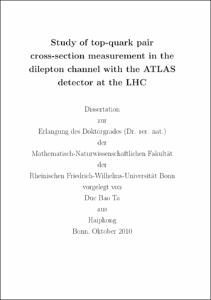Ta, Duc Bao: Study of top-quark pair cross-section measurement in the dilepton channel with the ATLAS detector at the LHC. - Bonn, 2011. - Dissertation, Rheinische Friedrich-Wilhelms-Universität Bonn.
Online-Ausgabe in bonndoc: https://nbn-resolving.org/urn:nbn:de:hbz:5N-26206
Online-Ausgabe in bonndoc: https://nbn-resolving.org/urn:nbn:de:hbz:5N-26206
@phdthesis{handle:20.500.11811/5024,
urn: https://nbn-resolving.org/urn:nbn:de:hbz:5N-26206,
author = {{Duc Bao Ta}},
title = {Study of top-quark pair cross-section measurement in the dilepton channel with the ATLAS detector at the LHC},
school = {Rheinische Friedrich-Wilhelms-Universität Bonn},
year = 2011,
month = sep,
note = {The top quark is the heaviest of the known fundamental particles in the Standard Model (SM) with a mass of 173.3±1.1GeV. It is the sixth quark in the SM and the weak isospin partner of the bottom quark. Properties such as the mass and the cross section have been measured since its discovery in 1995 with great precision at the proton-antiproton Fermilab Tevatron Collider, Chicago at a centre-of-mass energy of 1.8GeV and 1.96GeV. With the start of the proton-proton CERN Large Hadron Collider (LHC), Geneva, a new record in the centre-of-mass energy was achieved. The LHC opens a new energy frontier and probes the SM at energies of the electroweak symmetry-breaking scale and beyond. The measurement of the top-quark pair cross-section at this new energy is an important step, since it will either re-establish the SM at these energies by confirming the theoretical calculations or it can point to new phenomena that help to understand the so far not explained experimental findings in particle physics and cosmology.
This thesis presents a study of the production cross-section measurement of topquark pair in the dilepton channel at the LHC with the ATLAS experiment at a centre-of-mass energy of √s =10TeV and for a data amount of Lint.=200 pb-1. This study investigates the performance of the cross-section measurement with a cut-and-count analysis on Monte Carlo simulated samples. Important background processes are taken into account such as leptonically decaying Z-boson and single top-quark events. Data-driven background methods for Z-boson and fake event rates are discussed. A full list of systematic uncertainties is investigated and finally combined with the statistical uncertainties in a likelihood to extract the combined uncertainty. A “top mass”-like variable is presented that can help to distinguish dileptonic top-quark pair decays from similar signatures in new physics models. The combined sensitivity of the analysis in all dilepton decay-channels is a relative uncertainty on the cross-section measurement of:
+3.1% -3.1%(stat) +9.6% -8.7% (syst) +26.2% -17.4% (lumi)
Finally the study is compared to the same analyses performed at different centre-of-mass energies of 14 GeV and 7 GeV and two dilepton ttbar-pair event candidates in 280 pb-1 of first ATLAS data are presented.},
url = {https://hdl.handle.net/20.500.11811/5024}
}
urn: https://nbn-resolving.org/urn:nbn:de:hbz:5N-26206,
author = {{Duc Bao Ta}},
title = {Study of top-quark pair cross-section measurement in the dilepton channel with the ATLAS detector at the LHC},
school = {Rheinische Friedrich-Wilhelms-Universität Bonn},
year = 2011,
month = sep,
note = {The top quark is the heaviest of the known fundamental particles in the Standard Model (SM) with a mass of 173.3±1.1GeV. It is the sixth quark in the SM and the weak isospin partner of the bottom quark. Properties such as the mass and the cross section have been measured since its discovery in 1995 with great precision at the proton-antiproton Fermilab Tevatron Collider, Chicago at a centre-of-mass energy of 1.8GeV and 1.96GeV. With the start of the proton-proton CERN Large Hadron Collider (LHC), Geneva, a new record in the centre-of-mass energy was achieved. The LHC opens a new energy frontier and probes the SM at energies of the electroweak symmetry-breaking scale and beyond. The measurement of the top-quark pair cross-section at this new energy is an important step, since it will either re-establish the SM at these energies by confirming the theoretical calculations or it can point to new phenomena that help to understand the so far not explained experimental findings in particle physics and cosmology.
This thesis presents a study of the production cross-section measurement of topquark pair in the dilepton channel at the LHC with the ATLAS experiment at a centre-of-mass energy of √s =10TeV and for a data amount of Lint.=200 pb-1. This study investigates the performance of the cross-section measurement with a cut-and-count analysis on Monte Carlo simulated samples. Important background processes are taken into account such as leptonically decaying Z-boson and single top-quark events. Data-driven background methods for Z-boson and fake event rates are discussed. A full list of systematic uncertainties is investigated and finally combined with the statistical uncertainties in a likelihood to extract the combined uncertainty. A “top mass”-like variable is presented that can help to distinguish dileptonic top-quark pair decays from similar signatures in new physics models. The combined sensitivity of the analysis in all dilepton decay-channels is a relative uncertainty on the cross-section measurement of:
+3.1% -3.1%(stat) +9.6% -8.7% (syst) +26.2% -17.4% (lumi)
Finally the study is compared to the same analyses performed at different centre-of-mass energies of 14 GeV and 7 GeV and two dilepton ttbar-pair event candidates in 280 pb-1 of first ATLAS data are presented.},
url = {https://hdl.handle.net/20.500.11811/5024}
}






